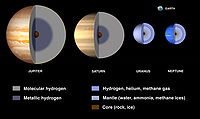Fichier:Gas Giant Interiors fr.jpg
Gas_Giant_Interiors_fr.jpg (692 × 409 pixels, taille du fichier : 88 kio, type MIME : image/jpeg)
Ce fichier et sa description proviennent de Wikimedia Commons.
Description
| DescriptionGas Giant Interiors fr.jpg |
Deutsch: Gasriesen: Interner Aufbau
English: Gas Giant Interiors Jupiter Saturn Uranus Neptune Français : Schéma de l'intérieur d'une géante gazeuse. Polski: Budowa wewnętrzna planet-olbrzymów Português: Interior dos gigantes gasosos Svenska: Gasjättarnas inre. |
||
| Date | |||
| Source |
Ce fichier est dérivé de : Gas Giant Interiors.jpg:  |
||
| Auteur | Couronne Boréale (traduction) | ||
| Autres versions |
[modifier]
|
Conditions d’utilisation
- Vous êtes libre :
- de partager – de copier, distribuer et transmettre cette œuvre
- d’adapter – de modifier cette œuvre
- Sous les conditions suivantes :
- paternité – Vous devez donner les informations appropriées concernant l'auteur, fournir un lien vers la licence et indiquer si des modifications ont été faites. Vous pouvez faire cela par tout moyen raisonnable, mais en aucune façon suggérant que l’auteur vous soutient ou approuve l’utilisation que vous en faites.
- partage à l’identique – Si vous modifiez, transformez, ou vous basez sur cette œuvre, vous devez distribuer votre contribution sous la même licence ou une licence compatible avec celle de l’original.
Légendes
Éléments décrits dans ce fichier
dépeint
13 avril 2022
13 avril 2022
image/jpeg
Historique du fichier
Cliquer sur une date et heure pour voir le fichier tel qu'il était à ce moment-là.
| Date et heure | Vignette | Dimensions | Utilisateur | Commentaire | |
|---|---|---|---|---|---|
| actuel | 13 avril 2022 à 15:27 |  | 692 × 409 (88 kio) | Simon Villeneuve | Uploaded own work with UploadWizard |
Utilisation du fichier
Les 3 pages suivantes utilisent ce fichier :
Usage global du fichier
Les autres wikis suivants utilisent ce fichier :
- Utilisation sur fr.wikibooks.org









